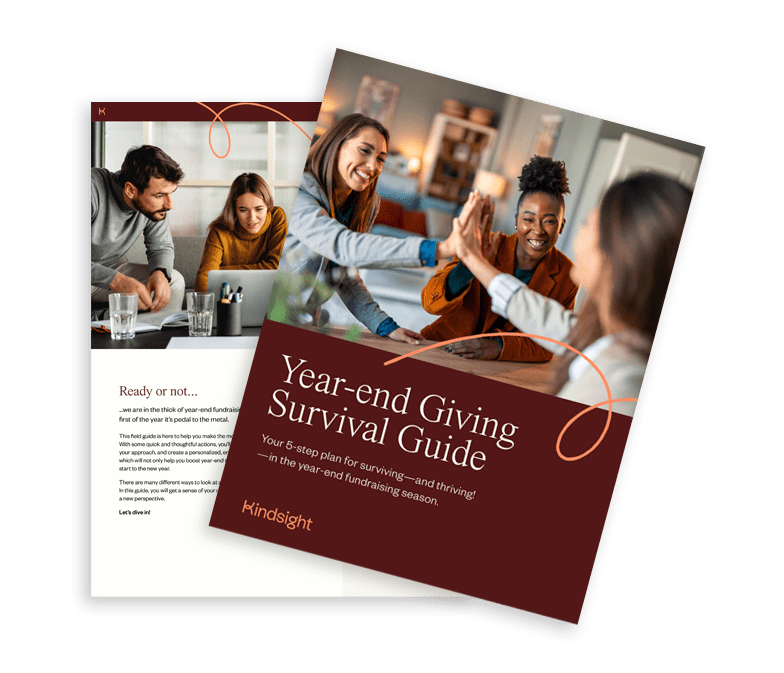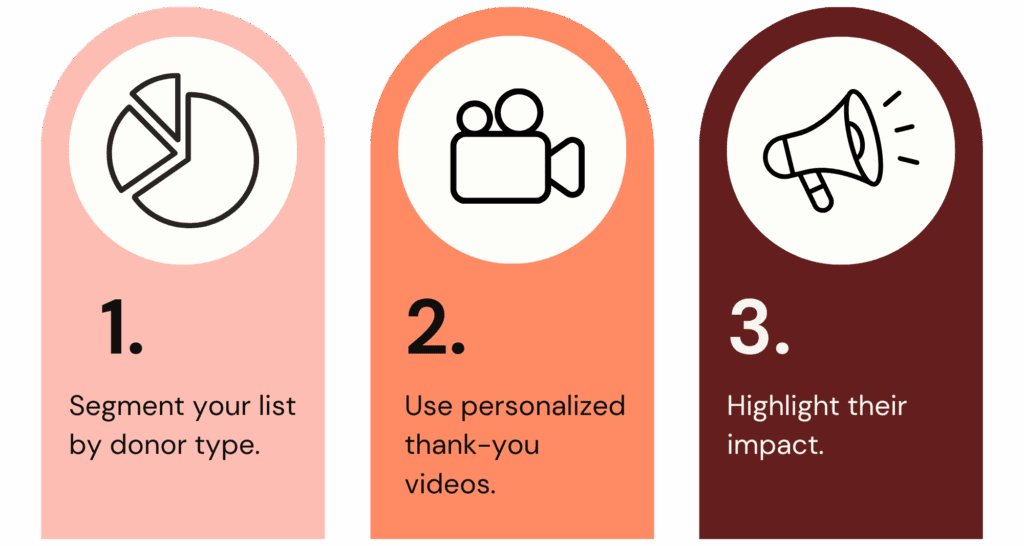
The final weeks of the year are a defining moment for many nonprofits, with as much as 30% of annual giving occurring in December alone. That makes the final two months of the year a critical year-end fundraising season, not only to finish the year strong financially, but also to deepen donor relationships and set the stage for the months ahead.
Great end-of-year fundraising campaigns combine thoughtful strategy, storytelling, and donor communications. If your giving season plans could use a creative lift, here are 15 practical, year-end giving campaign ideas designed to help your organization stand out, drive engagement, and maximize giving, all while staying true to your mission.
Read our related blog for more information on the steps to a successful year-end giving campaign.
1. Build excitement with a countdown to New Year’s Eve
Urgency drives action, and few approaches create urgency better than a countdown. One way to use this in your year-end appeal is to frame the campaign as a shared race toward the start of the new year.
Here are a year end countdown campaign few ideas to try:
- 12 days of impact: Share one powerful story or outcome each day leading up to New Year’s Eve, each with a direct tie-in to the funding that makes that impact possible.
- Countdown to change: Update donors weekly with your fundraising total, highlighting how each contribution is helping close the gap between their giving and your goals. Highlight how your goal will make a difference or change in the year to come.
- Final 72 hours push: As much as 10% of an organization’s annual giving is received in the last three days of the year. As the clock ticks down to midnight on December 31, send short, heartfelt reminders to your donors showing exactly what’s at stake if you fall short of your goal.
Visuals are particularly important with a countdown-style campaign. Thermometers, timers, and milestone posts delivered via email and on social media help to keep donors engaged and invested in your success throughout the campaign.
Need to hit the ground running?
Get a quick, 5-step plan for surviving—and thriving!—in the year-end fundraising season in our survival guide.

2. Empower supporters to lead peer-to-peer fundraising efforts
Peer-to-peer (P2P) fundraising is a powerful approach that can multiply your reach—and your giving totals—faster than any email blast or appeal. Donors and volunteers who advocate on your behalf bring a level of authenticity and trust that institutional messaging simply can’t replicate.
Some ideas for effective year-end P2P giving campaigns include:
- Holiday gift wrapping stations: Volunteers wrap presents in exchange for donations to your organization.
- Giving Tuesday ambassador campaigns: Board members and volunteers serve as ambassadors to work to raise support in the days leading up to Giving Tuesday
- Social media fundraisers: Supporters share personal stories and fundraising goals using built-in social media tools, inviting friends and family to contribute.
While peer-to-peer fundraising campaigns rely on the efforts of board members and volunteers, organizational planning is key. The best peer-to-peer campaigns offer participants easy-to-use templates, graphics, and example messages that make their participation simple. You’ll also want to celebrate your top fundraisers publicly. That recognition builds momentum, pride, and a little competition too.
3. Maximize impact with a matching gift campaign
Matching gifts are one of the most effective motivators for year-end giving. Whether a matching gift is funded by employers, a corporate sponsor, a major donor, or your board, they give donors the opportunity to make an even bigger impact with their giving. Strategic year-end campaign matches also create instant urgency, giving donors a clear goal to partner with your organization in achieving.
Frame your match clearly and compellingly, using language that communicates the match opportunity and the impact your donors’ gifts can make. Here’s an example: Every dollar you give this week will be doubled—up to $50,000—to help local families start the new year with hope.
Communicate deadlines, share progress updates, and spotlight stories that demonstrate what the match makes possible. Matching gifts not only boost revenue, but also build confidence among your donors that each gift, no matter how small, truly makes a difference.
4. Personalize the donor experience
Donors want to feel seen and valued, especially at the end of the year when their inboxes are overflowing with appeals. To stand out, go beyond a generic “Dear Friend” approach and tailor your messages to reflect donors’ unique connections to your work.
A few tactics to try as part of your year-end giving campaign ideas include:

- Segment your list by donor type: Dig into your fundraising CRM to identify recurring givers, first-time donors, and lapsed supporters. Craft distinct messages for each group.
- Use personalized thank-you videos: Get your staff, board members, or program participants on camera to express their gratitude.
- Highlight their impact: Customize donor messaging using AI tools for non-profits to acknowledge past giving, what those funds helped to accomplish, and how another gift can do even more.
The more personal the message, the stronger the emotional response it will elicit—and the more likely donors are to give to your organization now and in the future.
5. Host an inspiring in-person or virtual celebration event
Year-end fundraising doesn’t have to rely solely on appeals. Celebratory events—whether virtual, in-person, or hybrid—are an engaging way to honor your community, your donors, and the work you’ve completed together.
Here are a few creative ideas for events that spark generosity through celebration:
- Host a virtual “cheers to change” happy hour: Share stories, milestones, and donor shoutouts over Zoom or a livestream, honoring all you’ve achieved and the people who helped make it happen.
- Invite the community to attend a season of gratitude open house: Open the doors of your offices or facilities and invite donors to see your programs in action, meet some of the people they’ve helped, and even participate in the work of your mission.
- Hold a benefit concert or trivia night: Whether in-person or online, partner with local talent (especially if they’re personally connected to your organization!) to build energy and connection through a fun, entertaining evening.
Seamlessly incorporate giving opportunities such as text-to-give links, QR codes that lead to an online donation portal, or real-time giving updates throughout the event. These opportunities help convert the inspiration of the moment into immediate and lasting action.
6. Tell great stories
At the end of the year, compelling stories of transformation and hope are particularly powerful for effective fundraising. These thoughtful reflections remind donors why their support matters and what it makes possible.
Stories that you might consider highlighting include:
- An individual’s transformative journey, made possible through your programs.
- A reflection from staff or volunteers about the moments that inspired them this year.
- A year-in-impact video that pairs gratitude with tangible outcomes.
Frame your year-end campaign storytelling around your donors, telling them that these stories are possible because of their giving. That intentional perspective transforms your appeal from a request into an invitation, allowing donors to see themselves as active participants in your mission and to be an important part of something bigger.
7. Create a social media challenge
Social media offers a unique opportunity for donors to participate in your organizational story and how it’s told. Social media challenges invite donor participation, boost visibility, and attract new supporters through word-of-mouth momentum.
A few ideas for a year-end social media challenge include:
- Use smart hashtags like #MyReasonToGive: Ask followers to post about why they support your organization and to tag three friends to join them.
- Start an impact chain: When a donor gives to your organization, make it easy for them to share their donation—and to tag two others in the post to start the chain and keep it going.
- Make a gratitude countdown: Post one thing your team is grateful for each day in December, inviting followers to do the same and to tag your organization’s accounts.
The best social media challenges are fun, meaningful, and simple. Make it easy for people to participate by providing branded graphics and suggested captions, and make sure to engage directly with those who comment, share, and post their own related content.
8. Reimagine your direct mail fundraising strategy
Even in a digital-first world, direct mail remains one of the most effective year-end tools to drive donations. This is especially true when the messaging feels personal and story-driven.
Consider a few tactics to make your end-of-year giving letter powerful:
- Open your messaging with a first-person letter from a beneficiary or volunteer rather than a staff leader.
- Include a mini-impact report insert to showcase tangible results.
- Ask board members to add handwritten thank-you notes to top donors or long-time supporters.
While physical mail is powerful, its impact is magnified when you connect it to your digital strategy. Send an email teaser before the letter arrives and a follow-up after to create a multi-channel experience that keeps your organization top of mind in a busy season.
9. Extend Giving Tuesday into December
Giving Tuesday may be one day, but the energy it creates can power your entire year-end campaign. As you decide on year-end giving campaign ideas, consider Giving Tuesday not as a one-off donation event, but as the kickoff to a month-long celebration of generosity.
Here’s an idea of what that could look like:
- Launch your Giving Tuesday campaign with a specific goal and a clear match.
- Share impact updates in the following days and weeks.
- Transition from Giving Tuesday to a “Finish Strong” appeal mid-December to sustain momentum through the end of the year.
By linking Giving Tuesday to a larger campaign narrative, you can maintain excitement and avoid the post-Tuesday donation blues that many organizations experience.
10. Recognize donors in meaningful ways
Recognition is an important part of stewarding your donors, and end-of-year reflections offer a natural time to express gratitude and center your donors in your organizational story.
Examples of year-end campaign recognitions include:
- A digital wall of thanks on your website or social media.
- Personalized holiday e-cards or playlists curated by your team.
- A thank-you video montage featuring staff, volunteers, or clients saying what donor support meant this year.
- Exclusive sneak peeks of upcoming initiatives for those who give before December 31.
Recognition transforms giving from a transaction into a relationship, rightly positioning donors as a key part of your organizational success. Those relationships are what sustain nonprofits for the long term.
11. Highlight tax-smart giving options
The holiday spirit isn’t the only thing that influences year-end giving. Many donors wait until December to evaluate their financial situation and make thoughtful decisions. That makes it the perfect time to remind and inform donors of giving options that can maximize both impact and tax benefits, such as donor-advised funds (DAFs), stock gifts, and qualified charitable distributions (QCDs) from retirement accounts.
Ways to encourage tax-smart giving include:
- Adding a clear “Ways to Give” page on your website with information about each option.
- Including informational language like “Give smarter before December 31” in your email and social media content.
- Send a mid-December reminder to ensure donors have time to process gifts through financial institutions.
A little education goes a long way in driving year-end donations. Many donors simply don’t realize how easy—and beneficial—it can be to make a charitable giving donation before December 31st.
12. Launch a year-end giving circle push
For many nonprofit organizations, a giving circle or leadership society can elevate giving while fostering a sense of community. Many giving circles operate with an annual membership, starting either at the time of donation or with the new year. That makes it the perfect time to engage new donors or to renew those whose memberships are scheduled to lapse.
For example:
- Invite donors who give $1,000 or more by year-end to join a special Holiday Circle with exclusive updates and recognition.
- Share upcoming plans and initiatives for the new year to encourage new and returning giving circle members to join by the end of the year.
- Offer quarterly insider briefings or impact reports.
- Give early members a role in shaping future initiatives, creating a deeper connection to your mission.
Incorporated into your year-end giving campaign ideas, these programs nurture long-term loyalty while inspiring more substantial year-end gifts.
13. Center gratitude and stewardship
Amid the flurry of year-end activity, don’t lose sight of what matters most: gratitude. Stewardship during this season can help to define how donors feel about your organization heading into the new year.
Ways to show appreciation during the holiday season include:
- Send prompt thank-you emails within 24 hours of a gift.
- Follow up in January with a “What You Made Possible” impact summary.
- Have leadership or staff make personal thank-you calls to major or recurring donors.
These gestures take time, but it’s worth it. Good stewardship strengthens donor relationships and sets a positive tone for your 2026 campaigns.
14. Give your donation page a boost with better technology
The end of the year is a great time to make giving effortless. Streamlined, user-friendly donation technology boosts donor confidence and ensures that supporters can easily contribute whenever they’re inspired by the giving spirit.
A few ways to simplify giving with technology:
- Implement an easy-to-use online donor platform that guides donors smoothly through the process and allows them to set up monthly or annual donations.
- Streamline donation forms and platforms to be mobile-friendly and easy-to-use.
- Incorporate text-to-give options so supporters can make quick contributions with a simple message.
Good technology makes it easier than ever for donors to give, whether they’re caught up in a moment of inspiration or making strategic financial plans.
15. End the year with reflection and heart
No matter what year-end giving campaign ideas you implement, make sure you close them out with heart. A final message from your executive director, board chair, or a program participant can bring warmth and closure to your efforts.
Your message can be as simple as this: This year reminded us that generosity can change everything, and you made that possible. As we look toward the next year, we do so with gratitude for the community that carries our mission forward.
That final note of reflection and appreciation in a year-end giving letter will linger with your donors far beyond December.
Bringing it all together
Your year-end fundraising campaign is more than a sprint to meet financial goals; it’s an opportunity to celebrate, connect with, and inspire your donors and community. The most successful campaigns balance creativity with clarity, urgency with gratitude, and goals with genuine human connection.
At Kindsight, we believe great fundraising isn’t just about raising money. It’s about cultivating generosity and trust that lasts all year long. Whether you’re experimenting with peer-to-peer fundraising, elevating your storytelling, or introducing smarter giving options, remember that every interaction is a chance to remind donors why they matter.
Be the first to read our resources.
The world is changing quickly—and our resources help you stay on top of it all. Sign up to get new insights, success stories, and more, sent right to your inbox.




